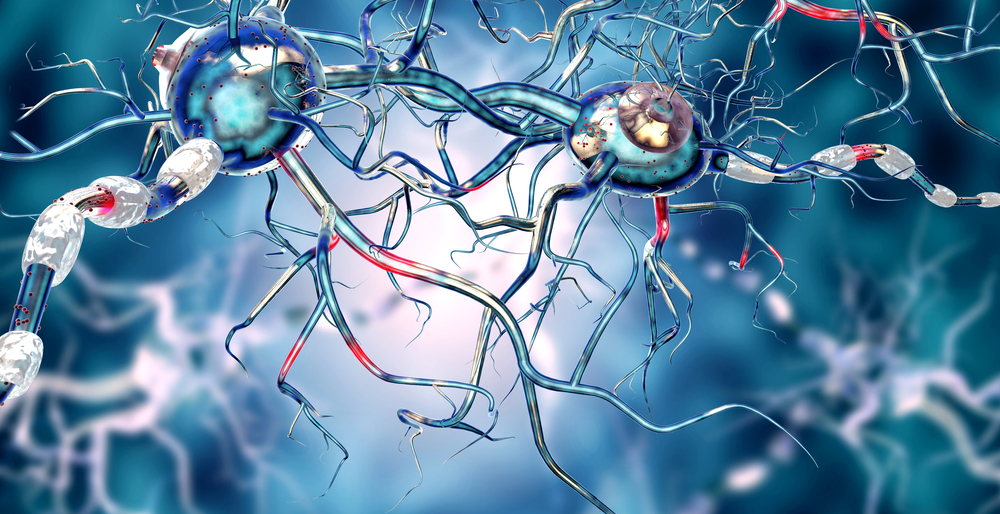Cerebrospinal Fluid May Transport ALS Toxins, Mouse Study Suggests

The clear, colorless liquid that fills and surrounds the brain and spinal cord may spread toxic protein aggregates from one nerve cell to others among people with amyotrophic lateral sclerosis (ALS), a study in mice suggests.
When repeatedly infused with the cerebrospinal fluid (CSF) from ALS patients, animals experienced motor and cognitive impairments, as well brain inflammation and other ALS-like alterations in their cells. This indicates CSF has a role in the propagation of disease features.
The study, “Transmission of ALS pathogenesis by the cerebrospinal fluid,” was published in Acta Neuropathologica Communications.
A molecular feature of ALS is the buildup of the TDP-43 protein in nerve cells. This protein normally functions to stabilize RNA molecules in the cells’ nucleus, but in ALS patients TDP-43 becomes improperly folded and accumulates in the cytoplasm, where it forms toxic protein aggregates, or clumps.
These clumps affect the normal function of mitochondria (the cells’ energy producers), and contribute to the death of motor neurons (the nerve cells controlling voluntary movement), resulting in progressive loss of motor function.
This protein also is thought to act like a prion, in which some misfolded TDP-43 prompts other, seemingly normal TDP-43 proteins to also fold inadequately and form clumps, a process that spreads the disease from one nerve cell to another.
Researchers have proposed that the CSF in ALS patients carries factors that can cause disease, potentially being a route for disseminating ALS, including the spreading of TDP-43 clumps in the brain and spinal cord.
Now, a team at the CERVO Brain Research Centre, Canada, conducted an experiment in mice in which the CSF from ALS patients was infused repeatedly in the CSF of animals carrying a human version of the TDP-43 protein. This human protein is necessary to study the spreading of TPD-43 clumps, since the infused CSF also is of human origin.
Researchers collected CSF samples from 10 patients with sporadic ALS (mean age 58 years) whose disease ranged from mild to severe. As controls, the team used samples from five age-matched individuals with normal pressure hydrocephalus pathology (NALS).
An initial experiment in motor neuron-like cells demonstrated that the pooled CSF from ALS patients increased the inflammation marker NF-κB and the cytoplasmic mislocalization of TDP-43.
In mice, injection of CSF from ALS (ALS-CSF) patients for 14 days also induced TDP-43 mislocalization and the formation of aggregates across motor neurons in the brain and spinal cord, a feature that was not observed in animals infused with control CSF or with a sham solution.
Compared to control animals, ALS-CSF-infused mice also experienced a loss of neuromuscular junctions (where nerve cells communicate with muscle cells), loss of reflexes, reduced physical performance, locomotion impairment, weight drop, and gait abnormalities. Animals also had alterations in muscle tissue, including muscle death, immune cell infiltration, fat accumulation, and muscle atrophy.
Notably, ALS-CSF infusion in mice without a human form of TDP-43 did not trigger TDP-43 buildup or clumping in motor neurons, but these animals also exhibited some motor impairments and muscle damage.
ALS-CSF administration resulted in significant nerve cell death, reduced by about 50% a neurotransmitter involved in the communication between motor neurons and muscles, and caused changes in neurofilament and peripherin levels that have been suggested to trigger motor neuron degeneration.
An assessment of the spinal cord white matter — a region enriched in nerve fibers — showed increases in astrocytes and microglial cells, both of which are known to contribute to damaging immune responses in the brain of ALS patients. Markers of inflammation, such as NF-κB and chitotriosidase, also were increased, while the anti-inflammatory marker arginase-1 was lowered.
Results also suggested that injecting CSF from ALS patients caused memory impairments and abnormal cognitive and behavioral patterns in mice.
Researchers then examined which proteins were being produced (translatome) across nerve cells from the mice’s hippocampus and cortex — two regions of the brain affected in ALS — after injection of ALS-CSF.
In addition to having much less proteins, likely reflecting a block in the conversion of mRNA information into proteins, these nerve cells also showed changes in their protein content that mostly suggested increases in metabolic stress, structural instability, and deficiencies in neurotransmission and in synaptic communications. (The synapse is the junction between two nerve cells that allows them to communicate.)
Further analyses demonstrated that mitochondria were aggregating in response to ALS-CSF and were not being replaced when needed. Other markers of mitochondrial function also were abnormal.
The findings support the idea that the CSF may contain toxic factors that are involved in spreading ALS, which may open “new research avenues on the discovery of new therapeutic targets,” the researchers wrote.
Additional studies are needed to understand which CSF factors are contributing to the disease-like features seen in mice, and whether distinct features arise from the CSF of patients with slow or fast progressive disease.
Also “future studies are needed to further examine the effects of longer time CSF administration on disease severity and to assess the effects of cessation of CSF infusion on disease progression,” the researchers concluded.






